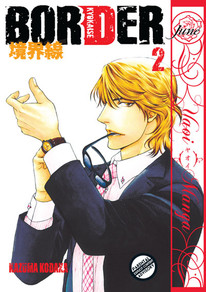Review
by Rebecca Silverman,Border
GN 2
| Synopsis: |  |
||
The boys are back – and not just the good ones. When the man who temporarily led Tamaki astray gets out of prison, he wastes no time in reestablishing his criminal empire. Yamato and his crew get the order to take him down, but for Tamaki, this is a personal mission. Meanwhile Assistant Detective Makita obsesses about tracking down Yamato, who he is convinced is a dangerous outlaw playing superhero. It may cost him his job, but in the pursuit of justice, only justice itself matters. |
|||
| Review: | |||
Raise your hand if you remember Weiss Kreuz. That tale of florists-by-day-assassins-by-night has a bit in common with Kazuma Kodaka's action/mystery series Border in that both feature groups of four attractive men (one significantly younger than the other three) taking orders from the man behind the curtain and fighting crime. But where Weiss had a large (unintentional?) camp factor, Border takes a route more reminiscent of American TV crime dramas, and the result is a familiar story that nevertheless is worth your time. Border's first volume dealt primarily with team leader Yamato, an orphan raised in a religiously-affiliated group home who grew up to join the military. This time the spotlight is on Tamaki, the bisexual hairdresser raised in the same home with Yamato. Where in the first book Tamaki came off as something of a fruity character, this time around we are treated to a glimpse of his less savory past. Tamaki was a troubled child and teen with abandonment issues. His jealousy of the attention given to the home's other children led him to run away and fall in with a bad crowd. This put him under the power of the volume's villain, Zama. He eventually escaped, but not without cost. Now Zama is out of jail and back on the streets, and he still has two of Tamaki's old friends in his power. Even though he is told that he can sit this one out, Tamaki is determined to make the world a better place by getting Zama out of it. Kodaka does not shy away from depicting the harsh underbelly of the criminal world, which more than the negligible sexual content gives this volume its explicit content warning. Scenes of torture, drug use, and out-and-out cruelty pervade the pages, and hints of sexual slavery are dropped. Zama himself is symbolically drawn leaning back in a deep chair, legs spread wide and a cruel smile on his face, calling up images of the stereotypical predatory male. His methods are unscrupulous and the hold he has on Tamaki's former friend is frightening. Likewise Tamaki's emotional state throughout the book is handled with some attention to detail, giving his choices a believable feel. In a story that is more about the action than the romance, despite the scrollwork proclaiming this “yaoi manga,” these details works very well. That is not to say that this volume is devoid of homosexual romance. Yamato is openly gay, and readers of volume one will remember the explicit scenes with his military lover. Tamaki isn't shy about his crush on Yamato and there is one make-out scene towards the end. All of that is ancillary to the action plot, however, so if you're looking for hot yaoi lovin', read a different book. On the other hand, this is a great series for the yaoi-curious (as the author said in volume one), particularly if you enjoy a “Leverage”-style mystery. At this point only Tamaki and Yamato have real definition to their characters. Sogo remains the quiet strong guy, Kippei is the cute young guy who can use a computer, and Makita's determination to unmask Yamato defines him. However last volume only Yamato had any distinction, so it looks as though Kodaka plans to build slowly over the course of the first few volumes – three's cover features Kippei, so that might indicate that he is the next arc's focus. The relationship between the four leads is a bit ambiguous, and it is unclear if everyone is in love with Yamato, or if it is only Tamaki. If nothing else, this is food for fantasies or thought, which may be why Kodaka chose to leave it undefined. Kodaka's art is more refined here than in her other June-released series, Kizuna and Bad Teacher's Equation. She maintains a universal thickness of line that gives her art a sense of clarity, and for the most part the action scenes work. There are a few awkward poses, generally when someone is in the act of kicking, and necks can achieve giraffe proportions at times, but overall the image work is solid. The translation is also good, maintaining a believable flow and vocabulary while sticking to a familiar crime drama cadence. Overall Border is an engaging, entertaining story that would be right at home airing on any basic cable channel. With a tight-knit core team of attractive crime-fighting men, a police detective on their trail, and a willingness to show the darker side of their missions, Border makes for good reading for the action fan. |
| Grade: | |||
|
Overall : B+
Story : A-
Art : B+
+ Engaging, gritty plot, heroes you can get behind. Good emotional arc for Tamaki. |
|||
| discuss this in the forum (3 posts) | | |||
| Production Info: | ||
|
Full encyclopedia details about Release information about |
||